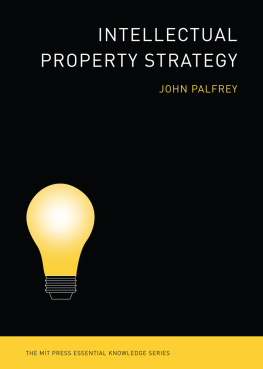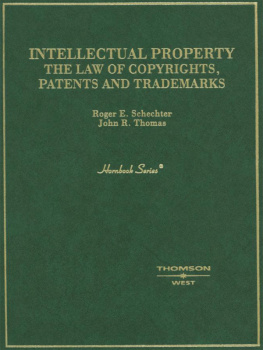Intellectual Property Strategy
The MIT Press Essential Knowledge Series
Information and the Modern Corporation, James W. Cortada
Intellectual Property Strategy, John Palfrey
Intellectual Property Strategy
John Palfrey
The MIT Press | Cambridge, Massachusetts | London, England
2012 Massachusetts Institute of Technology
All rights reserved. No part of this book may be reproduced in any form by any electronic or mechanical means (including photocopying, recording, or information storage and retrieval) without permission in writing from the publisher.
MIT Press books may be purchased at special quantity discounts for business or sales promotional use. For information, please e-mail or write to Special Sales Department, The MIT Press, 55 Hayward Street, Cambridge, MA 02142.
This book was set in Chaparral Pro by the MIT Press. Printed and bound in the United States of America.
Library of Congress Cataloging-in-Publication Data
Palfrey, John G.
Intellectual property strategy / John Palfrey.
p. cm.
Includes bibliographical references and index.
ISBN 978-0-262-51679-2 (pbk. : alk. paper)
ISBN 978-0-262-29799-8 (retail e-book)
1. Intellectual propertyManagement. I. Title.
HD53.P35 2011
658.152dc22
2011011493
10 9 8 7 6 5 4 3 2 1
For Terry Fisher, whose every idea makes perfect sense immediately
SERIES FOREWORD
The MIT Press Essential Knowledge series presents short, accessible books on need-to-know subjects in a variety of fields. Written by leading thinkers, Essential Knowledge volumes deliver concise, expert overviews of topics ranging from the cultural and historical to the scientific and technical. In our information age, opinion, rationalization, and superficial descriptions are readily available. Much harder to come by are the principled understanding and foundational knowledge needed to inform our opinions and decisions. This series of beautifully produced, pocket-sized, soft-cover books provides in-depth, authoritative material on topics of current interest in a form accessible to nonexperts. Instead of condensed versions of specialist texts, these books synthesize anew important subjects for a knowledgeable audience. For those who seek to enter a subject via its fundamentals, Essential Knowledge volumes deliver the understanding and insight needed to navigate a complex world.
Bruce Tidor
Professor of Biological Engineering and Computer Science
Massachusetts Institute of Technology
PREFACE
I have written this book in two related, yet distinct, formats. As a conventional matter, this book might be read in the printed form that you now hold in your hands. This is, purposely, a short book, designed to give you a primer on intellectual property strategy in no more time that it takes to fly, say, from New York to London or Boston to Los Angeles, if you were to read it cover-to-cover in a single sitting.
As an experimental matter, Ive also written the book, as well as a series of companion case studies and related material, to be read in a purely digital format. The idea behind this digital version is to experiment with whether a reader might benefit from a presentation of these ideas that is at once both linear and nonlinear. While you can make your way through the text just as you might the conventional, printed version (albeit on a screen), you are offered a series of places where you might take a deeper dive into one or more topics that especially interest you.
These potential diversions, built into the digital version of the book, take the form of a series of case studies and short videos. These supplements are designed to enable you to go deeper on many of the big themes developed in the conventional form of the book. Via links within the text, you will find connections to case studies on a range of topics. For instance, these cases take up follow-on biologics, an important form of innovation in the market for lifesaving drugs internationally; the practice of licensing trademarks in the collegiate market; university technology commercialization; open innovation, in particular the InnoCentive model; the story of Starbucks and its attempts to trademark coffee from Africa; and the licensing opportunities seized by major museums, such as the Louvre in France.
These brief cases also include links to the open web. My hope is that you might at some point, after such a detour, return to the book, rather than allowing yourself to be pulled into the deeper web. Even if you dont return to the book, that is a risk I consider worth taking. There is, after all, more to be said on the topic of intellectual property strategy than Ive included in either version of this book.
The videos are interviews that I have recorded with experts in the field of intellectual property. You can watch these videos in full, via the iPad application or on YouTube. You will also find pointers to snippets from the videos embedded in the text of the digital version of the book in places where I encourage you to take a detour to hear from someone other than me, the primary author.
Last, and most important in a way, I hope that you will talk back: to challenge the ideas Ive put forward here in this book, online and in public, to help build our common understanding of the world of ideas, knowledge, and innovation in todays global marketplace. It is through this kind of public exchange that we can together grow smarter about intellectual property.
ACKNOWLEDGMENTS
I owe thanks to a great team of collaborators. June Casey, my colleague at Harvard Law School, has proven to me, yet again, how important truly great librarians are, especially in a digital era. June provided substantive and editorial advice on both the main text and the online materials, including the case studies, videos, and user interface. She also managed and supported an able group of law students who have also contributed mightily to this project. In partnership with June, David Jacobs researched and drafted most of the case studies that accompany this volume. Daniel Doktori researched and drafted the case on university technology licensing. Andrew Breidenbach provided valuable research assistance for the primary text of the book. My colleagues at the Berkman Center for Internet & Society at Harvard University have provided deep inspiration. Dean Martha Minow, Terry Fisher, Urs Gasser, Lawrence Lessig, Phil Malone, and Jonathan Zittrain have been generous with their ideas. Margy Avery and her team at the MIT Press, as well as the group of blind peer reviewers that she assembled, have been a pleasure to work with. My family, as ever, has been patient and supportive through yet another book project that cut into my time on the playground and Little League diamond.
INTRODUCTION
The Self-Limiting Myth of the Sword and the Shield
Copyrights: Your Sword and Your Shield.
S&E EntertainmentMusic Publishing, October 1, 2009
The sword and shield of patent protection: Nokia v. Apple/Apple v. Nokia.
Chris F. Lonegro, Ober Kaler law firm, February 2, 2010
In the first instance, intellectual property rights in patent, trademark or copyright are used as a sword.... [In other cases, l]itigation becomes a shield.
Intellect Law Group, 2010
[Intervention by a competition authority is justified w]hen a patent owner uses his patent rights not only as a shield to protect his invention, but as a sword to eviscerate competition unfairly.
Atari Games Corp. v. Nintendo, 897 F.2d 1572 (Fed. Cir. 1990)
In conventional wisdom, intellectual property strategy is about the sword and the shield. As a sword, intellectual property can be used to attack a competitor who seeks to exploit some aspect of your intellectual property in a way that violates your rights. As a shield, intellectual property can help you to stave off the attacks of your competitors. Thats still truebut only to an extent. This outdated metaphor, invoking the battlefield, suggests that you should control and exploit your intellectual property to the greatest extent allowed by law in every instance, no matter the context and no matter who you are. This theory no longer describes the best approach for most institutions, much of the time.
Next page















